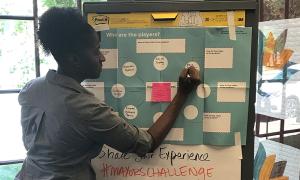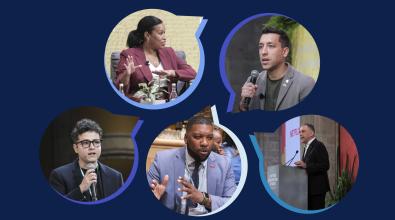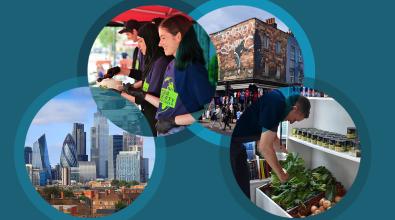On the ground in 300-plus U.S. city halls

Eight weeks ago, Bloomberg Philanthropies challenged itself to kick-start the latest nationwide wave of public-sector innovation by holding as many “Idea Accelerator” workshops in hundreds of city halls across the United States. Part of the 2017 Mayors Challenge — an innovation competition designed to empower U.S. cities to tackle their most pressing concerns — the workshops were created to help leaders take the first steps in that process: identify their top problems, engage stakeholders, and assess capabilities and resources. By this Friday, the foundation will have surpassed its goal, holding Idea Accelerator workshops in more than 300 cities — including 50 states and Washington, D.C. — for more than 3,000 city leaders. And as we learned from catching up with three of 46 workshop facilitators, this unprecedented series of innovation workshops provided invaluable insights for everybody involved.
How many workshops have you facilitated and how would you describe the experience?
Sania Salman (Idea Couture): I will have completed 18 workshops by the end of September, and it’s been a once-in-a-lifetime experience. The most fascinating part has been the way the curriculum showed city leaders how to take something that might, at first, be a broad, urgent problem and then whittle it down into a much more concrete and targeted aspect of that problem. During each, and every, workshop, there’s been a pivotal moment when I can tangibly see participants buy into the process.
Jennifer Park (Results For America): I facilitated three workshops. While I’ve led idea-generation and human-centered design workshops before, these were different — first, because they were for city governments and, second, because each city had different needs and different stakeholders in the room. City leaders are solutions-oriented, and it was incredible to help them to focus on articulating a problem rather than jumping straight into finding solutions.
Bjorn Whitmore (Bennett Midland): I facilitated four workshops, each of which involved a different energy, perspective, and, of course, issue. I loved seeing the productive tensions and unlikely partnerships the workshops brought out among the people in the room. Most of all, it was incredible to meet so many people dedicated to improving lives in their cities through local government.
Without naming any cities, what would you say is one of the most surprising moments over the past two months?
BW: I was in a small city dealing a dramatic rise in homelessness and a large increase of migrants from Latin America The participants came in wanting to address homelessness, but then they began to see that homelessness was a symptom of other challenges. About three quarters of the way through the day, all the people in the room — and this was the most diverse group I worked with, including church leaders, the school superintendent, business people, and the police department, among others — realized that the literacy and language gaps were the biggest challenges their city faces. By the end of the day they had coalesced around addressing these challenges as the root of homelessness and other issues. I was amazed by this mind shift over the course of only one day, and the moment when everyone realized they wanted to work together on literacy was both surprising and inspiring.
SS: One of the most surprising moments for me was when one smaller city had a huge moment of realization that American cities, though diverse, aren’t really all that different from one another. This city started off wanting to focus on how to become resilient in the face of unreliable federal and state funding. Then, when they broke that problem down into its component parts, they realized that American cities — big or small, rich or poor, east or west, urban or rural — all deal with very similar problems on a day-to-day basis. They concluded that, by focusing too much on their material differences, American cities are losing opportunities to build more resilient coalitions and a common sense of identity with one another. This was particularly poignant given how divisive our national politics have become. In a way, during this workshop, the city dared to envision a future where cities focused more on helping one another rather than magnifying their differences.
What one lesson did you share with attendees that you think would be helpful to everybody interested in government innovation?
SS: In order to be innovative, you’ve got to check your assumptions and have the audacity to admit when your understanding of the problem is wrong. Too often, we become attached to an idea or solution. Innovation requires that you approach the world not with answers but with questions. It requires a sense of endless curiosity and an awareness about your own biases and assumptions. I like asking participants, “Is there any inherent value in finding answers if the answers are to the wrong questions?” Take all your understanding, expertise, and data and validate it. Then, continuously arrange and rearrange and stack these blocks of knowledge in different ways to understand how you can truly make lasing change.
JP: You have to clearly identify the problem first. Cities are trying to address large and difficult challenges that can be tackled in so many different ways. Understanding the root of the problem, the scale of the problem, and the stakeholders involved should play a significant role in defining the solution you want to implement. Innovation isn’t only about doing something new, it also needs to be intentional and thoughtful.
What did your experience teach you about the state of U.S. cities?
SS: I wrongly assumed there wasn’t an appetite for innovation or, perhaps, there was a lack of passionate talent. I was proven wrong, repeatedly, on both accounts. What I’ve learned is two-fold: First, there is a perceptible hunger to be creative and forward-thinking and, second, there is a contagious passion for the continued success and progress of the city. These two characteristics go hand in hand. Many cities are looking to be innovative because they realize the only way to tackle some of their incredibly intractable problems is by finding avant-garde solutions that can leapfrog them into the future. American cities don’t lack talent, expertise, or even passion. But they need more enabling tools and resources to provide directional guidance and make an innovative future seem more attainable.
JP: There are so many problems to solve, and it’s inspiring to see that cities aren’t overwhelmed by them but are, instead, working across jurisdiction lines and sharing solutions with one another. I also learned that cities are most successful in addressing these challenges they bring the right folks to the table — and this includes both the naysayers and people directly affected by the problem.
BW: To be frank, I learned that, in a lot of cities, qualitative research, deliberative problem analysis, and resident engagement aren’t typically integrated into daily work. While I was a bit surprised by this, it gave me great belief in the mission of the Mayors Challenge. In addition, in every city I visited, there were individuals in the room who latched onto the idea of investigating a problem in depth before turning to solutions, and were excited to take the work forward. In one city, it was the chief of staff, but in another it was the head of human resources for the police department. This is just to say that there are dedicated, hard-working, smart people in every city in the U.S., and giving them the tools and space to think about their challenges in a new way is a powerful opportunity.


